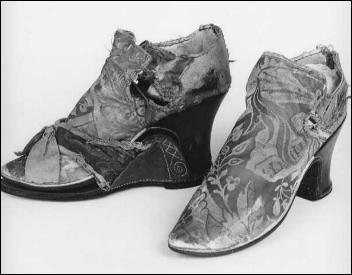|
Old
Pamp and the Slippers of Papillon Hall.
Papillon Hall (now virtually demolished) was built in 1622
by the Papillon family. It stood about 1 mile from the village
and was octagonal in shape, with only one entrance as each
room connected. The large stone house was surrounded by a
moat. At each corner of the roof was a flat lead paved area.
One owner, David Papillon (1691-1762) was known by local people
as Pamp, Old Pamp or Lord Pamp and was greatly feared. Many
people believed he was in league with the Devil. They believed
he could 'set' or 'fix' people who offended him. One story
tells how he did just this to a group of ploughmen who became
unable to move until 'released' at the end of the day. If
anybody in Lubenham suffered a misfortune they blamed Old
Pamp, and it is told that villagers made a cross in their
dough when baking or in the mash when brewing beer to avert
his evil eye.
It is told that before his marriage he kept a Spanish mistress.
She was kept 'prisoner' in the east attic and took her exercise
on the flat leads of the roof. She died in 1715. There is
no record of her death or of her place of burial, but the
skeleton of a woman was found within the walls of the east
attic during alterations to the hall in 1903. Folklore tells
that she was murdered by Papillon who accused her of being
a witch. At the moment of death, it is told, she uttered a
curse that ill fortune would befall any owner who removed
her slippers from the house.

The Slippers of Papillon Hall
photo kindly loaned by David Allen
Because
of this, whenever the hall was sold the slippers were handed
with the title deeds to the new owners, except in 1866, when
they were taken away to Leicester. The new family were constantly
awakened at night by unexplained loud noises and so the slippers
were brought back and the noises ceased.
The house was sold again six years later and the new owner,
Thomas Holford, lent the slippers (silver brocade with three
inch heels and pointed toes) to an exhibition in Paris. Life
in the house became so unbearable that the family were forced
to move out until the slippers were returned.
The next owner, Mr. C Walker, who bought the hall in 1884,
was so determined to avoid trouble that he had a special case
made for them with a padlocked metal grille keeping the slippers
securely mounted above the fireplace. However, despite warnings,
Captain Frank Belville who bought the hall in 1903 had the
slippers removed to his solicitors during alterations (during
which the skeleton was found) and accidents immediately befell
the workers with one being killed by a falling brick. The
men refused to work. Shortly after, Belville himself sustained
a broken skull in a fall from his pony and trap and the slippers
were hurriedly brought back. Despite this experience in 1909
he lent the slippers to an exhibition at Leicester Museum.
Whilst they were away he had a bad fall from his horse whilst
hunting and the hall was set on fire during a tremendous thunder
storm. Three horses were also killed and some say that two
men also died. Once more the shoes were brought back and this
time Belville locked them securely in the cabinet and threw
the key into the pond.
The shoes were safe until the second world war, when the hall
was used as a billet for the American 82nd Airborne Division.
The story goes that on two separate occasions men who had
taken slippers away were killed in action, though the missing
slipper was returned each time. When the hall was deserted
in 1945 only one slipper remained, but in 1951 when the hall
was demolished the missing slipper was found under the floorboards.
 This shows
3 of the many US service men of the 82nd Airborne Div who
were stationed at the hall during WW2. The picture shows them
standing outside the hall next to the ornamental pond. This
picture was taken just prior to there departure to operation
Market Garden. The one in the middle is a Captain Sartain
who survived the war and went on to become a judge in Baton
Rouge Louisiana.
This shows
3 of the many US service men of the 82nd Airborne Div who
were stationed at the hall during WW2. The picture shows them
standing outside the hall next to the ornamental pond. This
picture was taken just prior to there departure to operation
Market Garden. The one in the middle is a Captain Sartain
who survived the war and went on to become a judge in Baton
Rouge Louisiana.
photo
kindly loaned by David Allen
The slippers
were donated by Mrs. Barbara Papillon to Leicester Costume
Museum in 1981.
No more has been heard of the curse, but some Lubenham folk
still remember tales of Old Pamp and his mysterious mistress.
Note:
The remains of Papillon Hall can be reached from the main
road between Lubenham and Theddingworth (about 600 metres
from the village) along a track-marked field footpath to Gumley
(close to Bramfield Caravan Park). There remains a high wall
standing at the back of a small meadow, with a ruined summer
house, two gate piers, and a few steps leading down to an
ornamental pond.
Read
local man David Allen's fascinating and detailed historical
account of the story and his strange visit to see the hall's
remains and the slippers themselves!
|